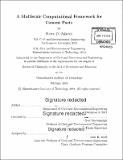A multiscale computational framework for cement paste
Author(s)
Palkovic, Steven D. (Steven David)
DownloadFull printable version (28.57Mb)
Other Contributors
Massachusetts Institute of Technology. Department of Civil and Environmental Engineering.
Advisor
Oral Büyüköztürk.
Terms of use
Metadata
Show full item recordAbstract
Cement paste is the matrix phase in mortar and concrete that exhibits a hierarchical structure spanning orders of magnitude in length scales. These complexities have prevented systematic studies of structure-property relationships. This understanding is necessary to design sustainable cementitious materials that substitute locally available additives for ordinary Portland cement (OPC), while still achieving a mixture with high strength, stiffness and durability. To address this challenge, we develop a multiscale framework connecting molecular details with macroscale performance. This is accomplished through modeling that captures the essential structures and interactions at atomistic (~1 nm), colloidal (~100 nm), and microstructural (~100 [um) length scales. Models are developed and validated through appropriate experiments to ensure realistic configurations and interactions. We begin with the layered molecular structure of calcium-silicate-hydrate (C-S-H), the fundamental building block that is the binding phase in cementitious materials. Through combined loading simulations of the planar geometry, we find that a water-filled interface between calcium-silica layers exhibits a cohesive-frictional behavior with a normal-stress dependency of the maximum shear strength. We propose a cohesive-frictional force field (CFFF) to realistically capture the intrinsic strength anisotropy of this interface between larger-scale assemblies of colloidal C-S-H nanoparticles. The CFFF is parameterized directly from atomistic simulations, coarse-graining the effective behavior of thousands of atoms to a single colloidal pair interaction. We generate polydisperse assemblies of particles and use the CFFF to investigate the mechanical response of the solid-pore composite. Our results show that cohesive-frictional colloid interactions lead to a significant amplification of the normal-stress dependency that is in agreement with nanoindentation and cm-scale triaxial loading experiments. To complete our study, we investigate a cement paste microstructure considering cohesive-frictional interactions of the hydrated phases. We introduce a novel method for generating model realizations from statistical distributions of mechanical properties measured from nanoindentation. This procedure is applied to hardened cement paste samples incorporating various proportions of OPC and a volcanic ash additive. Results show that the macroscale frictional behavior is insensitive to pm-scale features, including the spatial fluctuations of mechanical properties and presence of inclusions. This suggests that cohesive-frictional behavior is almost entirely attributed to nm-scale details like molecular interfaces and colloidal interactions. The agreement of our models with cm-scale laboratory compression experiments validates our bottom-up framework spanning 10-¹⁰ to 10-² m. This thesis is the first multiscale description of cement paste that utilizes discrete models to track the strength development of cementitious materials from molecular to macroscopic scales. Understanding the role of changes in structure and interactions on overall performance is essential for designing new materials incorporating additives. We hope that this achievement will provide a foundation for future exploration and will enable a paradigm shift in engineering the next generation of sustainable and durable cementitious building materials.
Description
Thesis: Ph. D., Massachusetts Institute of Technology, Department of Civil and Environmental Engineering, 2018. Cataloged from PDF version of thesis. Includes bibliographical references (pages 115-126).
Date issued
2018Department
Massachusetts Institute of Technology. Department of Civil and Environmental EngineeringPublisher
Massachusetts Institute of Technology
Keywords
Civil and Environmental Engineering.